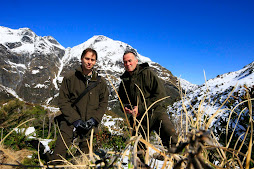Are we too reckless when attaching tracking equipment to our native birds? Are we using our native species as expendable guinea pigs? It seems we are ...
The author of the book
Kiwi Hunter, published in 2005, implies hundreds of our endemic kiwi are being killed due to poor methodology of researchers. His declaration is not an isolated occurrence.
There's plenty of evidence to show that radio-tagging birds is an invasive procedure that causes the birds stress and other physiological harm, and renders them less able to fend off predators. Some transmitters, after batteries run out, are left attached to birds, indefinitely.
Over 150 native birds are documented in Rare Bits (a DoC publication), as dying after being radio-tagged during research conducted between 2000 and 2004. In most cases there are no controls, so the results are merely observations, with no measurable comparisons.
This assembly of information from Rare Bits is just the tip of the iceberg. Here are a few excerpts ...
"To date, 63 kereru (wood pigeon) have been captured and survived at least a fortnight after being radio-tagged. Of these, 28 (44.4%) have died, giving a mean life expectancy of just 0.9 years! Although the cause of death or species of predator involved is not always obvious, the following are the assumed causes:"
"kiwi: So far five of the 11 chicks have been predated, and all in the centre of the treatment area. Surviving kiwi chicks are being left in the wild in the hope that stoat density will not recover quickly enough to make their fate certain. Unfortunately only one of the 11 monitored chicks hatched early enough in the season to get the full benefit of the aerial knock-down."
"Last season we monitored 14 kiwi chicks. This work was to measure chick survival in the wild after a very effective 21,000 ha aerial 1080 operation. Eight chicks successfully hatched in the wild: four were predated by stoats, one dropped its transmitter at 1370 g and three are still being monitored. Six eggs were taken to Rainbow due to nest abandonment and were hatched successfully. The new chicks were then released back into their parental territory in Tongariro forest. Three were predated by stoats, one died of hypothermia and two are still alive."
It's convenient to suggest that these results are to be expected - to just assume the deaths are a result of predation - after all, predation is big business. The problem is, the birds are also dying after "successful" poisoning operations, and are being sent to the front-line to test the effectiveness of the poisoning operations.
So what determines whether a poison operation is successful or not, and how long does the full benefit of an aerial knock-down last? A successful drop may mean killing rats and possums, but the real predator, the stoat, appears to be largely unaffected - and he's switching his prey. Murphy et al produced this paper ....
CHANGE IN DIET OF STOATS FOLLOWING POISONING OF RATS IN A NEW ZEALAND FOREST The researchers found that ... Although rats were the main prey item of stoats before the poisoning, stoat abundance was unaffected by the operation and there was a change in stoats' diet from rats to birds.
If aerial operations are "very effective" at killing pests, why are so many birds being fitted with radio-tags and effectively, being sent to the front-line to determine if predators remain in the drop-zone?
The number of radio-tagged birds that are assumed to have died by predation, is high.
If birds are declared to have been killed by a predator in poison operational areas, they are overlooked for testing for 1080 poison residues. Not surprisingly then, between 1999 and 2007, only one kiwi was tested for 1080 residues (revealed under the Official Information Act).
Documentation suggests hundreds of kiwi have died within this period. Why has only one bird been tested for 1080 poison residues? Surely, all native species found dead in poisoned areas should be tested, even where bait-stations are used?
In 2008 an endangered
takahe died at Mt Bruce, and the following month
4 adult kiwi died at Mt Bruce. The cause of the 4 kiwi deaths was deemed to be predation.
It wasn't to be the last time there was a predator attack at the heavily bait-stationed Mt Bruce.
12 kiwi died there last year. Of the 12 birds found dead, within the 4 week period, none were tested for poison residues. The cause of death was determined to be predation. It was reported that 2 ferrets managed to cover 950 hectares, to hunt down the 12 kiwi. Impressive.
DoC state that adult kiwi can fend off predators. An OIA request revealed that 10 of the 12 dead kiwi at Mt Bruce were adult birds, in good condition..
More recently,
6 Kaka died at Mt Bruce. Surprisingly, 3 were tested and found to have died from eating poison bait. Not surprisingly, all our curious, endemic parrots - kaka, kea, and kakariki - are attracted to poisonous bait, and have been found dead with poison residues in their carcasses.
After the kaka deaths a news item stated "The kaka were eating the cereal pellets containing the poison and Mr Lester (DoC) said staff immediately began adding metal plates to the 1200 bait stations within the reserve to stop the birds getting into the plastic containers."
The decision to test these birds was a good one. It proved that kaka are prone to eating poisonous food and will even break into bait stations to access it. It is not unreasonable to suggest that when poisonous food is dropped from helicopters, as in the recent
Project Kaka, in the Tararua Forest Park, that the birds will eat the toxic bait that's supposed to protect them. Especially when it's dropped into their nests.
We have filmed the impacts of poison drops, right across the country. We have found plenty of evidence of dead birds that have been scavenged. I suggest that if stoats are being poisoned in aerial operations, it is because they are predating on birds dying from 1080 poisoning and, or, scavenging on birds that have died from 1080 poisoning.
However, research suggests that stoat populations are not affected in poison drops.
Murphy et al found that ... Overall, rats and invertebrates were major components of stoat diet, occurring in 40.8% and 52.4% of guts respectively (Table 1). Mouse remains were found in 11.5% of guts. Lagomorphs and possums did not feature prominently in the diet. Bird remains were found in 19.3% of guts. Most of the bird remains that could be identified further were passerines, which occurred in 7.5% of guts (and included blackbirds Turdus merula and finches).
So is our willingness to sacrifice our native birds to measure predator populations, and the "success" of poisoning operations, something of the past?
It seems not. Just recently,
23 of 34 native Morepork (originally thought to be 31) died after being fitted with radio tracking equipment to determine the effects on the species after a 1080 poison operation in the Waitutu Valley, Fiordland.
And yesterday, we were
informed that the Tongariro Forest is about to get another dosing of 1080 - 20,000 hectares! (Some of the excerpts above are from 10 year old research, from aerial poison drops in the Tongariro Forest). And to top it off, DoC are going to be presenting more young, radio-tagged kiwi to the predators to try to determine if the 1080 drops still aren't working.
DoC spokesperson Nick Poutu, in yesterday's news item, stated "the aerial bait drop was an important goal for DoC, reducing the rat numbers in the forest as well as reducing the ferret and stoat populations from secondary poisoning. These predators have been responsible for a great deal of the local kiwi population recently, with large numbers of monitored adult kiwi succumbing to ferrets in the last couple of years," Mr Poutu said.
He said DoC would be monitoring the survival of kiwi chicks after the bait drop to see if it gave them any respite from stoat predation."
This announcement by DoC yesterday, that "large numbers of monitored adult kiwi" are still being killed by predators, is more evidence that aerial poison drops clearly aren't working. DoC have been aerially poisoning the Tongariro Forest for decades. If aerial drops were working, these birds wouldn't be dying. All birds found dead in aerial drop-zones should be tested for poison residues.
We keep doing the same thing, year after year - and the results are the same - large numbers of dead, native birds, and no evidence of benefit. Research is important, but our willingness to use our native wildlife as bait - and our efforts to prove that the use of broad-spectrum, poison-laced food doesn't kill wildlife - needs to be stopped. It's time to stop risking our native wildlife to predation and poisoning operations, and to start targeting the pests in our forests, directly.
One of the most informative assembly of information and facts about aerial 1080 drops in New Zealand, in an easy to access medium, is the documentary
Poisoning Paradise.







